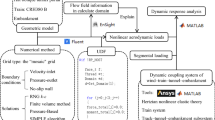Abstract
In order to study unsteady aerodynamic loads on high speed trains passing by each other 350km/h, three-dimensional flow fields around trains during the crossing event are numerically simulated using three-dimensional Euler equations. Roe’s FDS with MUSCL interpolation is employed to simulate wave phenomena. An efficient moving grid system based on domain decomposition techniques is developed to analyze the unsteady flow field induced by the restricted motion of a train on a rail. Numerical simulations of the strain passing by on the double-track are carried out to study the effect of the train nose-shape, length and the existence of a tunnel on the crossing event. Unsteady aerodynamic loads-a side force and a drag force-acting on the train during the crossing are numerically predicted and analyzed. The side force mainly depends on the nose-shape, and the drag force depends on tunnel existence. Also. a push-pull (i.e. impluse force) force successively acts on each car and acts in different directions between the neighborhood cars. The maximum change of the impulsive force reaches about 3 tons. These aerodynamic force data are absolutely necessary to evaluate the stability of high speed multi-car trains. The results also indicate the effectiveness of the present numerical method for simulating the unsteady flow fields induced by bodies in relative motion.
Similar content being viewed by others
Abbreviations
- A, B, C :
-
Inviscid flux Jacobian
- C s :
-
Side force coefficient
- C d :
-
Drag coefficient
- C l :
-
Lift coeffient
- D :
-
Tunnel diameter or diagonal matrix
- E :
-
Total energy
- E, F, G :
-
Inviscid flux vector
- FDS :
-
Flux Difference Splitting
- FSA :
-
Fortified Solution Algorithm
- GLS :
-
Galerkin Least Squares
- I :
-
Identity matrix
- J :
-
Jacobian of transformation
- MUSCL :
-
Monotone Upstream-Centered Scheme for Conservation Law
- P :
-
Pressure
- Q :
-
Vector of conservative variables
- u, v, w :
-
Velocity vector
- x, y, z :
-
Cartesian coordinate
- γ:
-
Specific heat
- ϱ:
-
Density
- ξ, η, ζ:
-
Generalized coordinate
References
Fujii, K., 1992, “Unified Zonal Method Based on the Fortified Solution Algorithm,” ISAS Report No. 648.
Fujii, K. and Ogawa, T. 1995, “Aerodynamics of High Speed Trains Passing by Each Other,”Computers & Fluids, Vol. 24, No. 8, pp. 897–908.
Holmes, B. S., Dias, J., Rifai, S. M., Buell, J. C., Johan, Z., Sassa, T. and Sato, T., 1999, “Solution of Train-Tunnel Entry Flow Using Parallel Computing,” Computational Mechanics 23, pp. 124–129
Hwang, J. and Lee, D, 1998, “Development of Moving Grid Technique for Unsteady Analysis of High Speed Train”,Proceedings of the KSME 1998 Spring Annual Meeting, B, pp. 607–610.
Hwang, J. and Lee, D, 1999, “Numerical Simulation of Flow field around High Speed Trains Passing by Each Other,”AIAA Paper 99–3156.
Jameson, A., and Yoon, S., 1987, “Lower-Upper Implicit Schemes with Multiple Grids for the Euler Equations,”AIAA Journal, Vol. 25, pp. 929–935.
Kim, H., 1997, “Aerodynamic Analysis of a Train Running in a Tunnel(II)-Aerodynamics of Two-Trains,”Transaction. of KSME, pp. 983–995, No. 8, 21, 36.
Kwon, H., Lee, D., Lee. S., Kim. D. and Kang. S., 1998, “An Experimental Study on Propagation of Pressure Waves inside the Tunnel and Booming Noise by a High-Speed Train,”Proceedings of the KSME 1998 Fall Annual Meeting B, pp. 735–740.
Maeda, T. 1993, “Effect of Shape of Train Nose on Compression Wave Generated by Train Entering Tunnel,”Proceedings of the International Conference on Speedup Technology for Railway and Maglev Vehicles, PS3-8, pp. 315–319.
Mestreau, E., Lohner, R. and Aita, S., 1993, “TGV Tunnel Entry Simulations Using a Finite Element Code with Autometic Remeshing,”AIAA 93-0890
Ogawa, T. and Fujii, K., 1994, “Numerical Simulation of Compressible Flows Induced by a Train Moving into a Tunnel,”Computational Fluid Dynamics Journal, Vol. 3, No. 1.
Ogawa T. and Fujii, K., 1997, “Numerical Investigation of Three Dimensional Compressible Flows Induced by a Train Moving Into a Tunnel,”Computers & Fluids, Vol. 26, No. 6, pp. 565–585.
Peters, J. L., 1983, “Aerodynamics of Very High Speed Trains and Maglev Vehicles: State of the are and Future Potential,”Int. J. of Vehicle Design, Technological Advances in Vehicle Design Series, SP3, Impact of Aerodynamics on Vehicle Design, pp. 308–341.
Rai, M. M. and Hessenius, K., 1986, “Three Dimensional Conservative Euler Computations Using Patched Grid System and Explicit Methods,”AIAA-86-1081.
Roe, P. L., 1981, “Approximate Riemann Solvers, Parameter Vectors, and Difference Schemes,”Journal of Computational Physics, Vol. 43, pp. 357–372.
Shimbo, Y., Hosaka, S., 1993, “Steady and Unsteady Pressure Measurement on High Speed Train,”Proceedings of the International Conference on Speedup Technology for Railway and Maglev Vehicles, PS3-14, pp. 341–346.
Steger, J. L., Dougherty, F. C. and Benek, J. A., 1983, “A Chimera Grid Scheme,”Advances in Grid Generation, FED Vol. 5, ASME, edited by Ghia, K. N., New York, pp. 59–69.
Author information
Authors and Affiliations
Corresponding author
Rights and permissions
About this article
Cite this article
Hwang, J., Lee, DH. Unsteady aerodynamic loads on high speed trains passing by each other. KSME International Journal 14, 867–878 (2000). https://doi.org/10.1007/BF03184475
Received:
Revised:
Issue Date:
DOI: https://doi.org/10.1007/BF03184475




